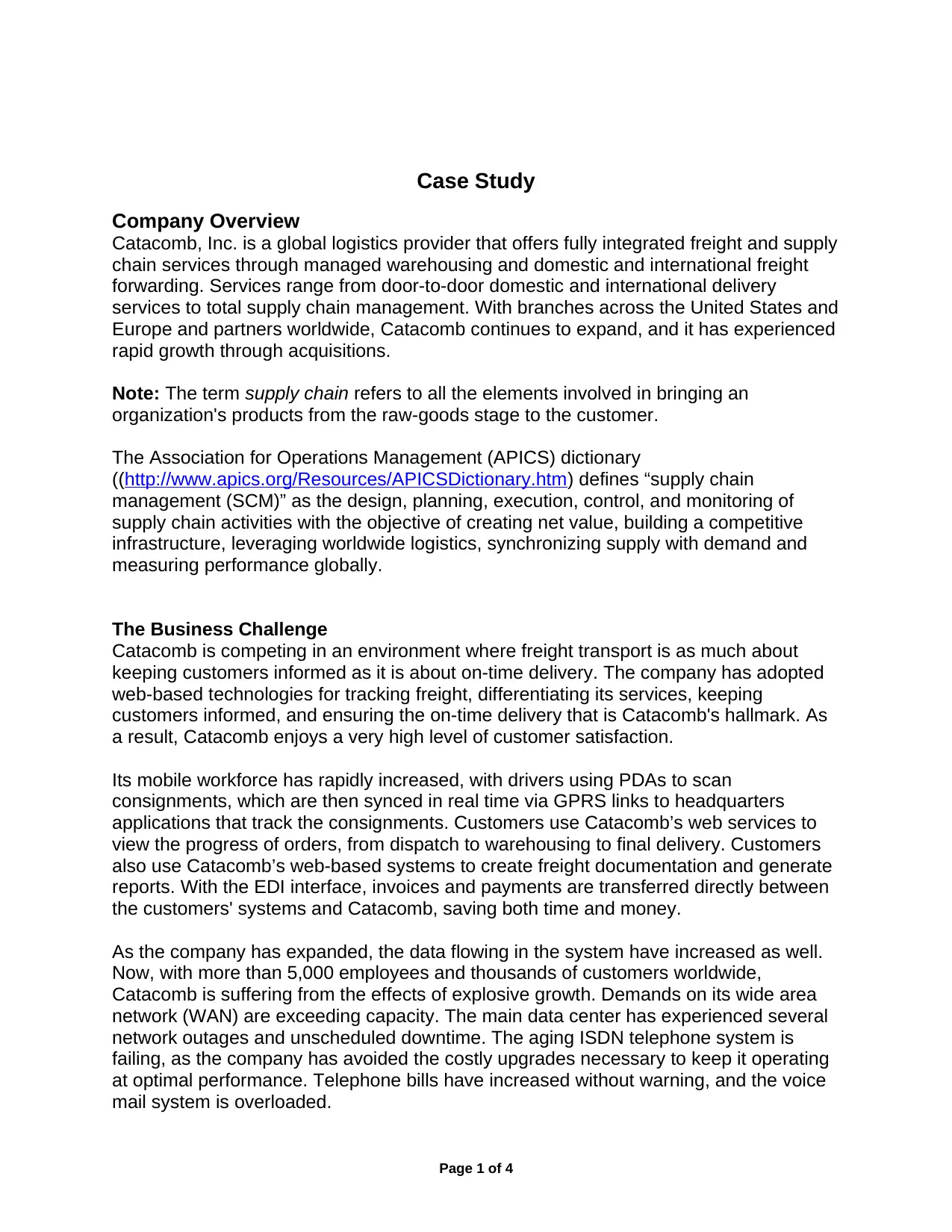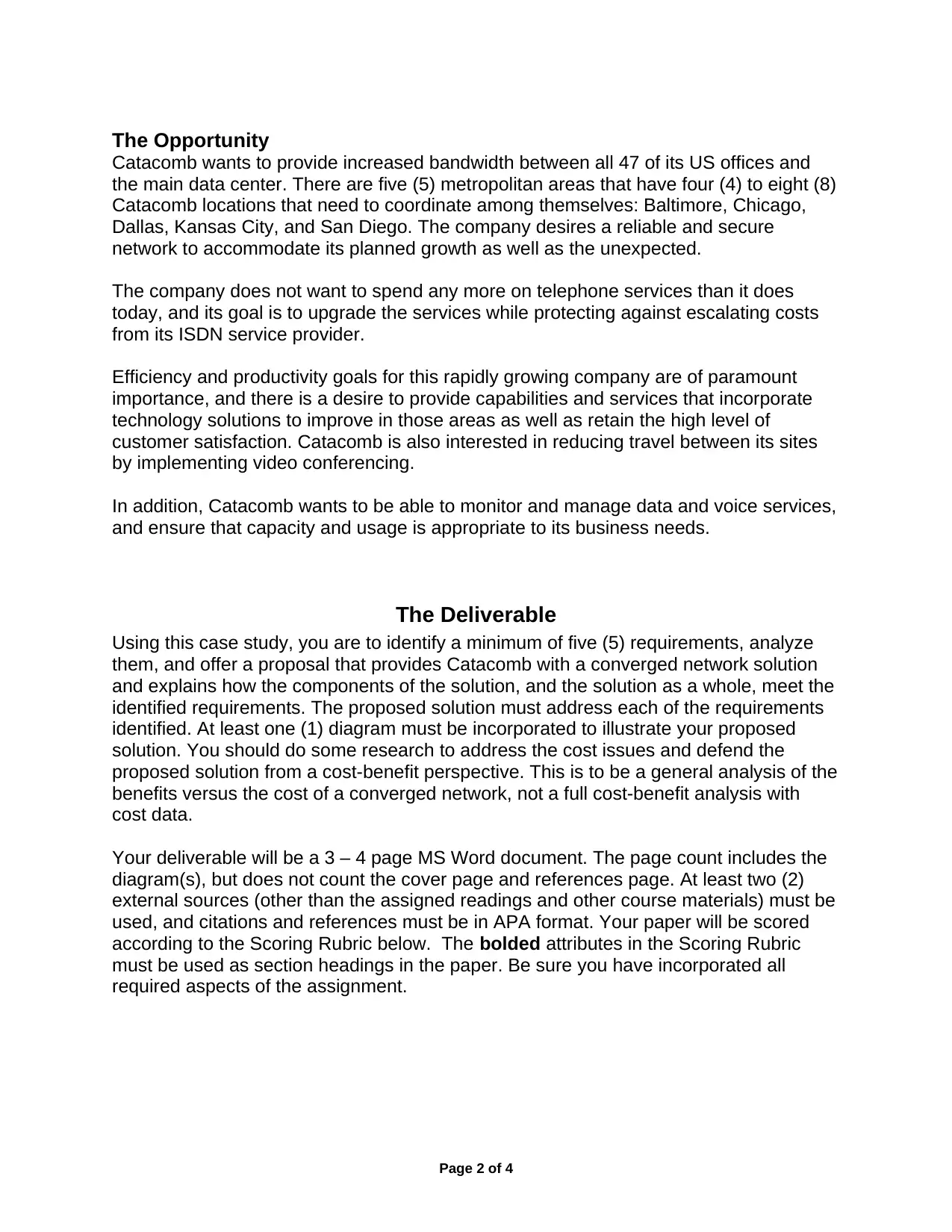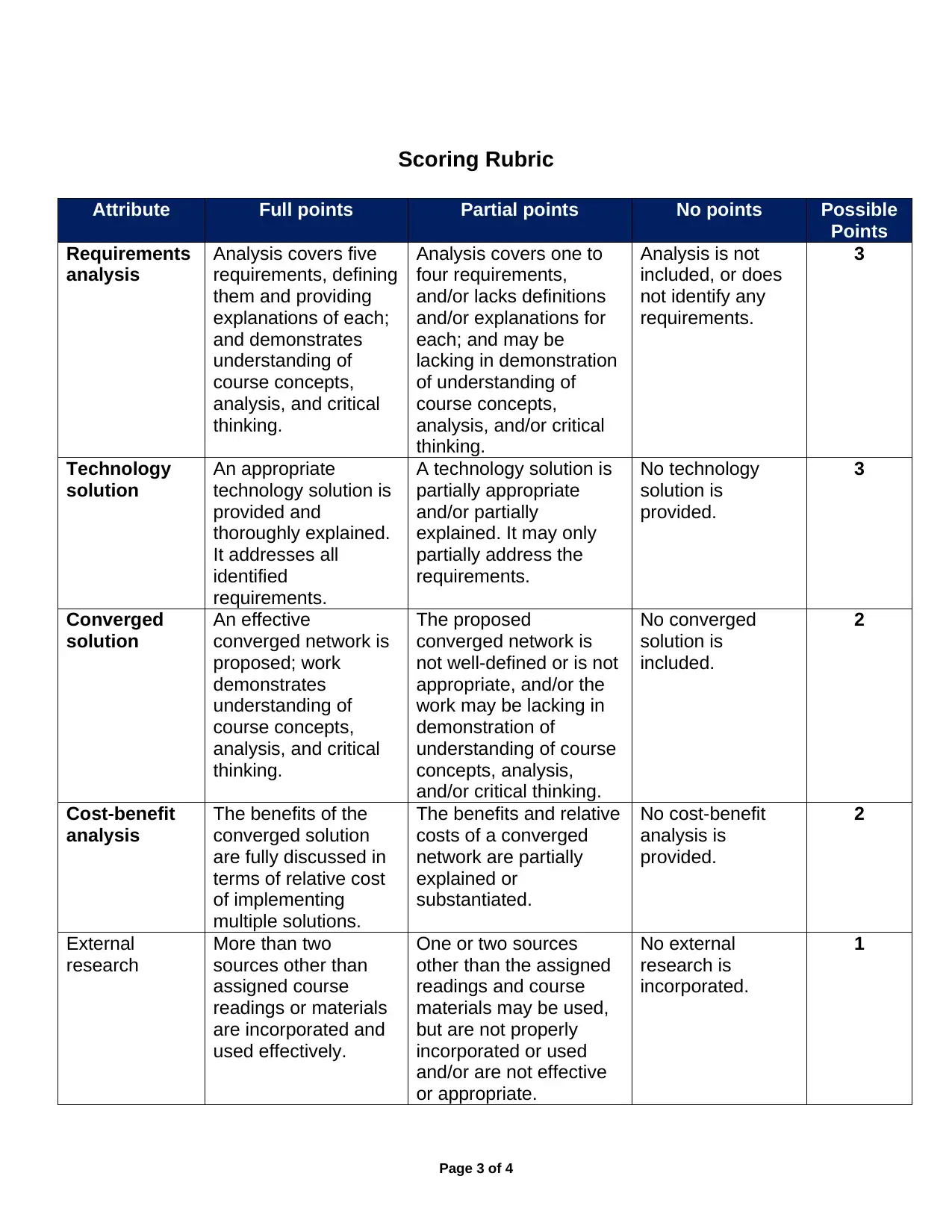Analysis and Proposal: Catacomb Inc. Network Infrastructure Upgrade
VerifiedAdded on 2019/10/18
|4
|1266
|342
Case Study
AI Summary
This case study analyzes Catacomb Inc., a global logistics provider facing network challenges due to rapid growth. The company needs to upgrade its wide area network (WAN), address network outages, and replace its aging telephone system. The assignment requires identifying five requirements, proposing a converged network solution, and explaining how it meets those needs. The solution must include at least one diagram and a cost-benefit analysis. The goal is to improve efficiency, productivity, and customer satisfaction while reducing costs. The solution must address issues like increased bandwidth, video conferencing, and network monitoring. The analysis should be based on the case study, external research, and APA formatting.

Case Study
Company Overview
Catacomb, Inc. is a global logistics provider that offers fully integrated freight and supply
chain services through managed warehousing and domestic and international freight
forwarding. Services range from door-to-door domestic and international delivery
services to total supply chain management. With branches across the United States and
Europe and partners worldwide, Catacomb continues to expand, and it has experienced
rapid growth through acquisitions.
Note: The term supply chain refers to all the elements involved in bringing an
organization's products from the raw-goods stage to the customer.
The Association for Operations Management (APICS) dictionary
((http://www.apics.org/Resources/APICSDictionary.htm) defines “supply chain
management (SCM)” as the design, planning, execution, control, and monitoring of
supply chain activities with the objective of creating net value, building a competitive
infrastructure, leveraging worldwide logistics, synchronizing supply with demand and
measuring performance globally.
The Business Challenge
Catacomb is competing in an environment where freight transport is as much about
keeping customers informed as it is about on-time delivery. The company has adopted
web-based technologies for tracking freight, differentiating its services, keeping
customers informed, and ensuring the on-time delivery that is Catacomb's hallmark. As
a result, Catacomb enjoys a very high level of customer satisfaction.
Its mobile workforce has rapidly increased, with drivers using PDAs to scan
consignments, which are then synced in real time via GPRS links to headquarters
applications that track the consignments. Customers use Catacomb’s web services to
view the progress of orders, from dispatch to warehousing to final delivery. Customers
also use Catacomb’s web-based systems to create freight documentation and generate
reports. With the EDI interface, invoices and payments are transferred directly between
the customers' systems and Catacomb, saving both time and money.
As the company has expanded, the data flowing in the system have increased as well.
Now, with more than 5,000 employees and thousands of customers worldwide,
Catacomb is suffering from the effects of explosive growth. Demands on its wide area
network (WAN) are exceeding capacity. The main data center has experienced several
network outages and unscheduled downtime. The aging ISDN telephone system is
failing, as the company has avoided the costly upgrades necessary to keep it operating
at optimal performance. Telephone bills have increased without warning, and the voice
mail system is overloaded.
Page 1 of 4
Company Overview
Catacomb, Inc. is a global logistics provider that offers fully integrated freight and supply
chain services through managed warehousing and domestic and international freight
forwarding. Services range from door-to-door domestic and international delivery
services to total supply chain management. With branches across the United States and
Europe and partners worldwide, Catacomb continues to expand, and it has experienced
rapid growth through acquisitions.
Note: The term supply chain refers to all the elements involved in bringing an
organization's products from the raw-goods stage to the customer.
The Association for Operations Management (APICS) dictionary
((http://www.apics.org/Resources/APICSDictionary.htm) defines “supply chain
management (SCM)” as the design, planning, execution, control, and monitoring of
supply chain activities with the objective of creating net value, building a competitive
infrastructure, leveraging worldwide logistics, synchronizing supply with demand and
measuring performance globally.
The Business Challenge
Catacomb is competing in an environment where freight transport is as much about
keeping customers informed as it is about on-time delivery. The company has adopted
web-based technologies for tracking freight, differentiating its services, keeping
customers informed, and ensuring the on-time delivery that is Catacomb's hallmark. As
a result, Catacomb enjoys a very high level of customer satisfaction.
Its mobile workforce has rapidly increased, with drivers using PDAs to scan
consignments, which are then synced in real time via GPRS links to headquarters
applications that track the consignments. Customers use Catacomb’s web services to
view the progress of orders, from dispatch to warehousing to final delivery. Customers
also use Catacomb’s web-based systems to create freight documentation and generate
reports. With the EDI interface, invoices and payments are transferred directly between
the customers' systems and Catacomb, saving both time and money.
As the company has expanded, the data flowing in the system have increased as well.
Now, with more than 5,000 employees and thousands of customers worldwide,
Catacomb is suffering from the effects of explosive growth. Demands on its wide area
network (WAN) are exceeding capacity. The main data center has experienced several
network outages and unscheduled downtime. The aging ISDN telephone system is
failing, as the company has avoided the costly upgrades necessary to keep it operating
at optimal performance. Telephone bills have increased without warning, and the voice
mail system is overloaded.
Page 1 of 4
Paraphrase This Document
Need a fresh take? Get an instant paraphrase of this document with our AI Paraphraser

The Opportunity
Catacomb wants to provide increased bandwidth between all 47 of its US offices and
the main data center. There are five (5) metropolitan areas that have four (4) to eight (8)
Catacomb locations that need to coordinate among themselves: Baltimore, Chicago,
Dallas, Kansas City, and San Diego. The company desires a reliable and secure
network to accommodate its planned growth as well as the unexpected.
The company does not want to spend any more on telephone services than it does
today, and its goal is to upgrade the services while protecting against escalating costs
from its ISDN service provider.
Efficiency and productivity goals for this rapidly growing company are of paramount
importance, and there is a desire to provide capabilities and services that incorporate
technology solutions to improve in those areas as well as retain the high level of
customer satisfaction. Catacomb is also interested in reducing travel between its sites
by implementing video conferencing.
In addition, Catacomb wants to be able to monitor and manage data and voice services,
and ensure that capacity and usage is appropriate to its business needs.
The Deliverable
Using this case study, you are to identify a minimum of five (5) requirements, analyze
them, and offer a proposal that provides Catacomb with a converged network solution
and explains how the components of the solution, and the solution as a whole, meet the
identified requirements. The proposed solution must address each of the requirements
identified. At least one (1) diagram must be incorporated to illustrate your proposed
solution. You should do some research to address the cost issues and defend the
proposed solution from a cost-benefit perspective. This is to be a general analysis of the
benefits versus the cost of a converged network, not a full cost-benefit analysis with
cost data.
Your deliverable will be a 3 – 4 page MS Word document. The page count includes the
diagram(s), but does not count the cover page and references page. At least two (2)
external sources (other than the assigned readings and other course materials) must be
used, and citations and references must be in APA format. Your paper will be scored
according to the Scoring Rubric below. The bolded attributes in the Scoring Rubric
must be used as section headings in the paper. Be sure you have incorporated all
required aspects of the assignment.
Page 2 of 4
Catacomb wants to provide increased bandwidth between all 47 of its US offices and
the main data center. There are five (5) metropolitan areas that have four (4) to eight (8)
Catacomb locations that need to coordinate among themselves: Baltimore, Chicago,
Dallas, Kansas City, and San Diego. The company desires a reliable and secure
network to accommodate its planned growth as well as the unexpected.
The company does not want to spend any more on telephone services than it does
today, and its goal is to upgrade the services while protecting against escalating costs
from its ISDN service provider.
Efficiency and productivity goals for this rapidly growing company are of paramount
importance, and there is a desire to provide capabilities and services that incorporate
technology solutions to improve in those areas as well as retain the high level of
customer satisfaction. Catacomb is also interested in reducing travel between its sites
by implementing video conferencing.
In addition, Catacomb wants to be able to monitor and manage data and voice services,
and ensure that capacity and usage is appropriate to its business needs.
The Deliverable
Using this case study, you are to identify a minimum of five (5) requirements, analyze
them, and offer a proposal that provides Catacomb with a converged network solution
and explains how the components of the solution, and the solution as a whole, meet the
identified requirements. The proposed solution must address each of the requirements
identified. At least one (1) diagram must be incorporated to illustrate your proposed
solution. You should do some research to address the cost issues and defend the
proposed solution from a cost-benefit perspective. This is to be a general analysis of the
benefits versus the cost of a converged network, not a full cost-benefit analysis with
cost data.
Your deliverable will be a 3 – 4 page MS Word document. The page count includes the
diagram(s), but does not count the cover page and references page. At least two (2)
external sources (other than the assigned readings and other course materials) must be
used, and citations and references must be in APA format. Your paper will be scored
according to the Scoring Rubric below. The bolded attributes in the Scoring Rubric
must be used as section headings in the paper. Be sure you have incorporated all
required aspects of the assignment.
Page 2 of 4

Scoring Rubric
Attribute Full points Partial points No points Possible
Points
Requirements
analysis
Analysis covers five
requirements, defining
them and providing
explanations of each;
and demonstrates
understanding of
course concepts,
analysis, and critical
thinking.
Analysis covers one to
four requirements,
and/or lacks definitions
and/or explanations for
each; and may be
lacking in demonstration
of understanding of
course concepts,
analysis, and/or critical
thinking.
Analysis is not
included, or does
not identify any
requirements.
3
Technology
solution
An appropriate
technology solution is
provided and
thoroughly explained.
It addresses all
identified
requirements.
A technology solution is
partially appropriate
and/or partially
explained. It may only
partially address the
requirements.
No technology
solution is
provided.
3
Converged
solution
An effective
converged network is
proposed; work
demonstrates
understanding of
course concepts,
analysis, and critical
thinking.
The proposed
converged network is
not well-defined or is not
appropriate, and/or the
work may be lacking in
demonstration of
understanding of course
concepts, analysis,
and/or critical thinking.
No converged
solution is
included.
2
Cost-benefit
analysis
The benefits of the
converged solution
are fully discussed in
terms of relative cost
of implementing
multiple solutions.
The benefits and relative
costs of a converged
network are partially
explained or
substantiated.
No cost-benefit
analysis is
provided.
2
External
research
More than two
sources other than
assigned course
readings or materials
are incorporated and
used effectively.
One or two sources
other than the assigned
readings and course
materials may be used,
but are not properly
incorporated or used
and/or are not effective
or appropriate.
No external
research is
incorporated.
1
Page 3 of 4
Attribute Full points Partial points No points Possible
Points
Requirements
analysis
Analysis covers five
requirements, defining
them and providing
explanations of each;
and demonstrates
understanding of
course concepts,
analysis, and critical
thinking.
Analysis covers one to
four requirements,
and/or lacks definitions
and/or explanations for
each; and may be
lacking in demonstration
of understanding of
course concepts,
analysis, and/or critical
thinking.
Analysis is not
included, or does
not identify any
requirements.
3
Technology
solution
An appropriate
technology solution is
provided and
thoroughly explained.
It addresses all
identified
requirements.
A technology solution is
partially appropriate
and/or partially
explained. It may only
partially address the
requirements.
No technology
solution is
provided.
3
Converged
solution
An effective
converged network is
proposed; work
demonstrates
understanding of
course concepts,
analysis, and critical
thinking.
The proposed
converged network is
not well-defined or is not
appropriate, and/or the
work may be lacking in
demonstration of
understanding of course
concepts, analysis,
and/or critical thinking.
No converged
solution is
included.
2
Cost-benefit
analysis
The benefits of the
converged solution
are fully discussed in
terms of relative cost
of implementing
multiple solutions.
The benefits and relative
costs of a converged
network are partially
explained or
substantiated.
No cost-benefit
analysis is
provided.
2
External
research
More than two
sources other than
assigned course
readings or materials
are incorporated and
used effectively.
One or two sources
other than the assigned
readings and course
materials may be used,
but are not properly
incorporated or used
and/or are not effective
or appropriate.
No external
research is
incorporated.
1
Page 3 of 4
⊘ This is a preview!⊘
Do you want full access?
Subscribe today to unlock all pages.

Trusted by 1+ million students worldwide

Attribute Full points Partial points No points Possible
Points
Document
format
The document reflects
effective organization
and correct sentence
structure, grammar,
and spelling; it is
presented in a
professional format; it
incorporates
illustrations or
diagrams; and
references are
appropriately
incorporated and
cited, using APA style.
The document is not
well-organized, and/or
contains grammar
and/or spelling errors; it
does not contain
appropriate illustrations
or diagrams; and/or it
does not follow APA
style for references and
citations.
The document is
extremely poorly
written and does
not convey the
information.
1
Total Points: 12
Page 4 of 4
Points
Document
format
The document reflects
effective organization
and correct sentence
structure, grammar,
and spelling; it is
presented in a
professional format; it
incorporates
illustrations or
diagrams; and
references are
appropriately
incorporated and
cited, using APA style.
The document is not
well-organized, and/or
contains grammar
and/or spelling errors; it
does not contain
appropriate illustrations
or diagrams; and/or it
does not follow APA
style for references and
citations.
The document is
extremely poorly
written and does
not convey the
information.
1
Total Points: 12
Page 4 of 4
1 out of 4
Related Documents
Your All-in-One AI-Powered Toolkit for Academic Success.
+13062052269
info@desklib.com
Available 24*7 on WhatsApp / Email
![[object Object]](/_next/static/media/star-bottom.7253800d.svg)
Unlock your academic potential
Copyright © 2020–2025 A2Z Services. All Rights Reserved. Developed and managed by ZUCOL.





